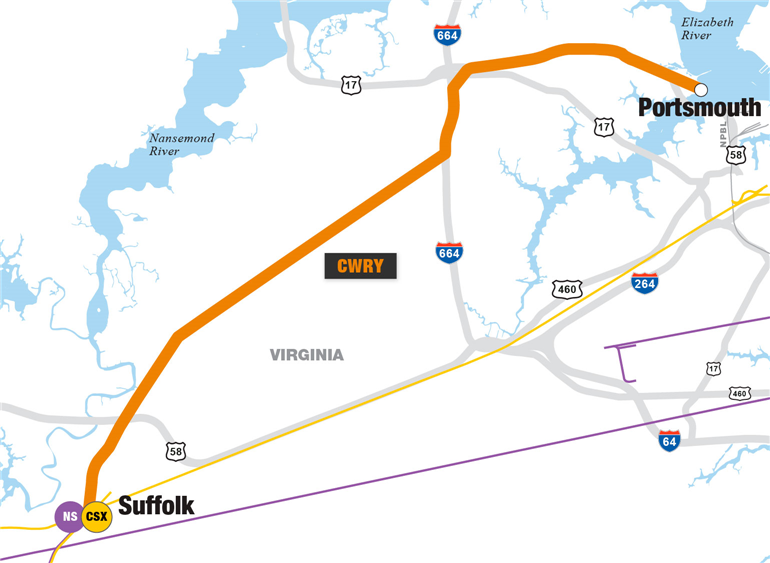
the Commonwealth Railroad connects the Virginia International Gateway (VIG) terminal to the CSX and Norfolk Southern in Suffolk
Source: Genesee & Wyoming Inc., Commonwealth Railway (CWRY)

the Commonwealth Railroad connects the Virginia International Gateway (VIG) terminal to the CSX and Norfolk Southern in Suffolk
Source: Genesee & Wyoming Inc., Commonwealth Railway (CWRY)
The Commonwealth Railway is a short-line Class III railroad servicing primarily the Virginia International Gateway (VIG) container terminal in Portsmouth. From the terminal's opening in 2007 until its sale to a new owner and renaming in 2014, it was known as the A. P. Moller (APM) terminal.
The Commonwealth Railway runs for 19 miles from Suffolk to the terminal in the West Norfolk area of Portsmouth. Major customers have included the BASF (formerly Ciba) specialty chemicals plant on the Nansemond River in Suffolk, the U S. Amines plant on the Elizabeth River, and the Virginia International Gateway (VIG) container terminal operated by the Virginia Port Authority on the Elizabeth River in Portsmouth.
If the proposed Craney Island Marine Terminal (CIMT) is constructed north of the Virginia International Gateway (VIG), the Commonwealth Railway would also carry containers to and from that shipping terminal as well.
The Commonwealth Railway connects to both the CSX and the Norfolk Southern in Suffolk. That flexibility provides shippers using the Virginia International Gateway (VIG) the option of using either Class I railroad to carry containers to their final destination. Dual access and the possibility of rail competition for shippers was ensured in 2006 when the Commonwealth Railway purchased over 12 miles of track that it had been leasing from Norfolk Southern.
The Commonwealth Railway track was originally built by the Atlantic and Danville Railroad in 1887, when it switched its eastern terminus from Claremont on the James River to West Norfolk. After the Southern Railway leased the Atlantic and Danville Railway in 1899, the West Norfolk terminal was abandoned and wharves at Pinners Point were used. When the 50-year lease expired, the Atlantic and Danville Railway restarted operations as an independent railroad. It obtained rights to continue using Pinners Point; the West Norfolk wharves were not rebuilt.
The site of the Pinners Point wharves is now the Portsmouth Marine Terminal (PMT). The Virginia International Gateway (VIG) was later built just north of the former West Norfolk terminal.
Two years after the Atlantic and Danville Railway went bankrupt in 1960, the Norfolk and Western Railway acquired it. The line was renamed the Norfolk, Franklin & Danville Railway.
In 1984, the Norfolk, Franklin & Danville Railway was incorporated into the Norfolk Southern. In 1996, the Norfolk Southern sold it to Genesee & Wyoming That company operates multiple short-line railroads intened to provide more cost-efficient "last mile" service than the Class I railroads. Genesee & Wyoming renamed their acquisition the Commonwealth Railway.
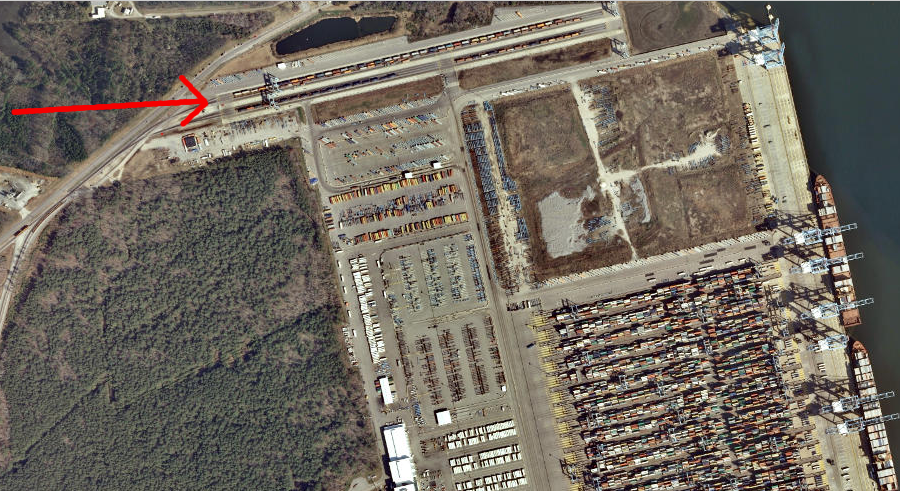
all containers going to or from the Virginia International Gateway (VIG) terminal by rail are carried by the short-line Commonwealth Railway, which connects to the CSX and Norfolk Southern
Source: ESRI, ArcGIS Online
In 1996, the short-line railroad served two chemical plants located on the Elizabeth River. They were located at the former site of the West Norfolk terminal, first constructed by the Atlantic and Danville Railroad in 1887 and abandoned after the 1899 lease to the Southern Railway. BASF closed its West Norfolk plant in 2007. That industrial site has been used for nearly a century to manufacture, insecticides, refrigerants, and a variety of other chemicals. Before closing, it was the site of BASF's Super Absorbent Polymers Plant and:1
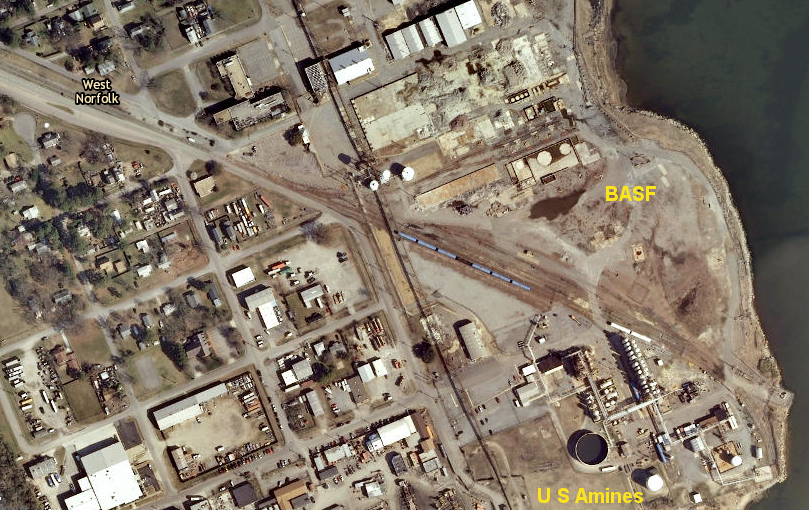
the now-demolished BASF chemical plant in the West Norfolk portion of Portsmouth was a major shipper on the Commonwealth Railway until it closed in 2007, but the U S. Amines plant remains in operation
Source: ESRI, ArcGIS Online
In 2006, the Commonwealth Railway had only two locomotives, three employees, and just three major customers. All three were chemical production facilities. Until A. P. Moller/Maersk finished construction of the A. P. Moller Terminal in 2007, the Commonwealth Railway carried no container traffic; the short line was not busy.
When the BASF plant at West Norfolk on the Elizabeth River closed, the U.S. Amines plant on the Elizabeth River and the Ciba specialty chemicals plant on the Nansemond River did not generate enough traffic to justify maintaining the railroad. If the new A. P. Moller (APM) terminal - now Virginia International Gateway (VIG) - had not opened on the Elizabeth River, the Commonwealth Railway would have shut down operations after BASF's Super Absorbent Polymers Plant closed.2
Today the Commonwealth Railway is an essential part of the transportation network for the Virginia International Gateway (VIG); it provides the only rail access. The Class III short-line railroad can interchange with two Class I railroads in Suffolk, CSX and Norfolk Southern. Those two lines compete with each other, with trucking companies, and with barge services to haul containers. Competition on prices and quality of service can attract shippers to send their large container vessels to the Virginia International Gateway (VIG) terminal, as opposed to other Hampton Roads terminals or terminals in other states.
When the A. P. Moller (APM) terminal first opened in 2007, the Commonwealth Railway still crossed multiple streets at grade in the cities of Portsmouth, Chesapeake, and Suffolk. Trains up to 7,500 feet long moving containers from the terminal would have blocked traffic at those crossings for excessively long periods of time, causing citizen complaints and interfering with the ability of fire/police to respond to events.
The short-term solution was to transport just short trains (up to 3,500 feet) from the terminal. Shorter trains created shorter, but more-frequent, delays at the highway rail crossings.
The next step was to upgrade the track so Commonwealth Railway locomotives could double their speed and pull trains at 20 miles/hour. There was little need for speed in the railroad's operations, but faster trains reduced the delays at street crossings.
Short trains were too inefficient for cost-effective, long-distance travel, so the Commonwealth Railway built a new marshalling yard east of Suffolk. Cars from the short trains coming from the terminal were combined at the marshalling yard into the longer trains required by CSX and Norfolk Southern, assembled for transport to terminals in other states such as Georgia and Pennsylvania.
The Suffolk Marshalling Yard could be expanded, but that would have required the expensive relocation of two large raw water pipelines constructed by the cities of Norfolk and Portsmouth.3
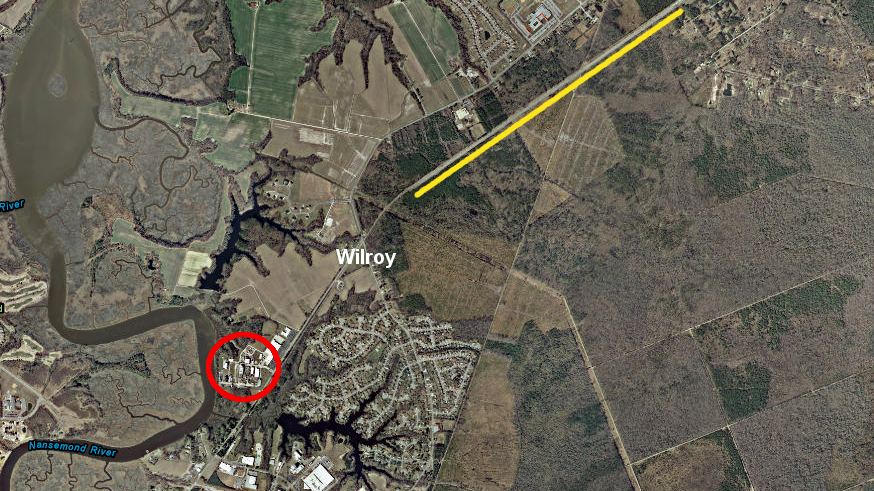
when the APM terminal opened in 2007, the Commonwealth Railway assembled longer trains at a new marshalling yard (yellow line), built northeast of the specialty chemicals plant (red circle) on the Nansemond River at Wilroy
Source: ESRI, ArcGIS Online
The long-term solution for eliminating train-caused congestion at South Hampton Roads street crossings was to abandon much of the old route built first by the Atlantic and Danville Railroad. The Commonwealth Railway constructed 4.5 miles of new track, located within the median strips of the Western Freeway (Route 164) and I-664.
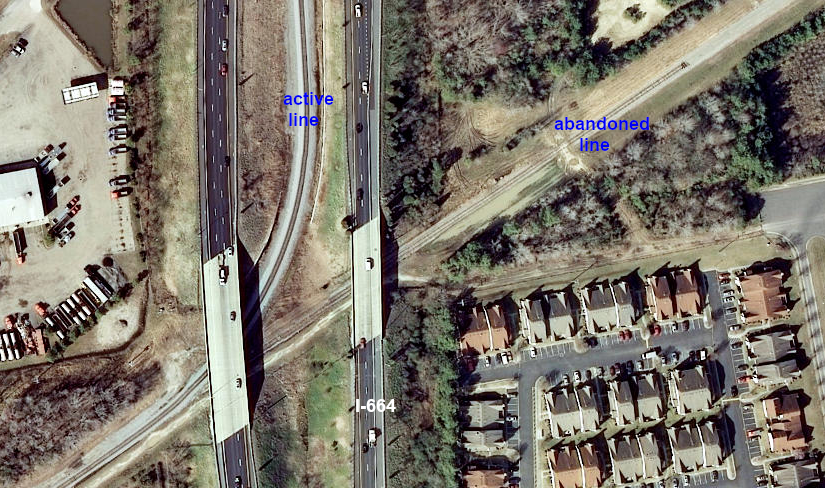
the Commonwealth Railway now curves north to run between the northbound and southbound lanes of I-664, and no longer follows the old straight route to the northeast
Source: ESRI, ArcGIS Online
When those highways were constructed in the 1980's, Western Freeway planners reserved space in an extra-wide median for freight rail tracks. The highway design anticipated construction of what is now the Virginia International Gateway (VIG) terminal. Relocating the Commonwealth Railway track was necessary only because of the container traffic from the new container shipping terminal. Only a small number of trains serviced the chemical plants, and the delays they caused would not have justified the expense.
The Virginia Port Authority managed the Commonwealth Railway Mainline Safety Relocation Project (Median Rail Project). It removed the rails on the old route after trains started using the track in the median strips of the Western Freeway in December, 2010.
Near Virginia International Gateway (VIG), the old route of the Commonwealth Railway was transferred to the Virginia Port Authority. The City of Chesapeake planned to convert the abandoned section of Commonwealth Railway track into the Western Branch Rails-to-Trails Multi-Use Path, also described as the Commonwealth Railway Trail. It was a component of the 41-mile South Hampton Roads Trail, connecting on the western edge of Chesapeake to the Suffolk Seaboard Coastline Trail.
Chesapeake acquired two miles of old trackbed from the Virginia Port Authority between the Portsmouth city line to I-664, and planned to acquire an additional mile of the abandoned Seaboard Coast Line trackbed between I-664 and the Suffolk city boundary. The city also planned to upgrade an existing trail, paving it with asphalt, to create a loop for bikers and pedestrians. Initial bids for the project in 2019 and 2020 came in above budget, however.4
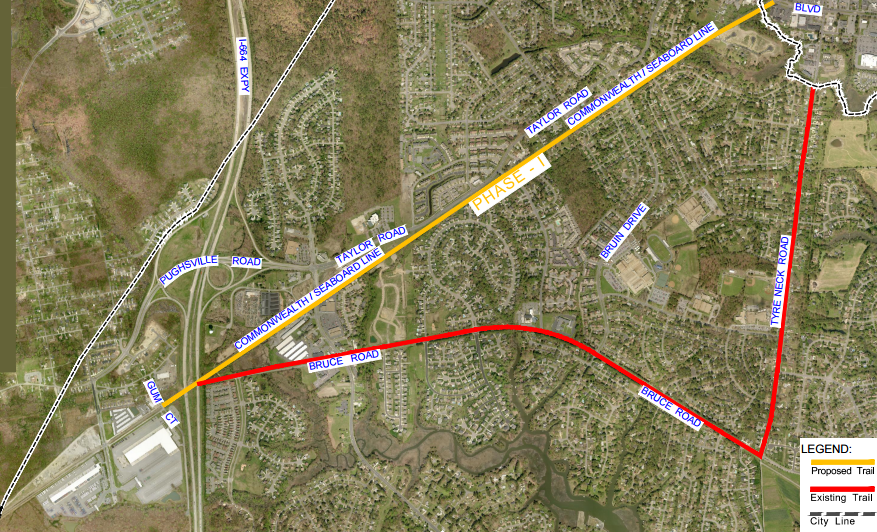
the old route of the Commonwealth Railway (straight yellow line) became a rails-to-trails project
Source: City of Chesapeake, Proposed Commonwealth Railway Trail in Western Branch, Phase - I
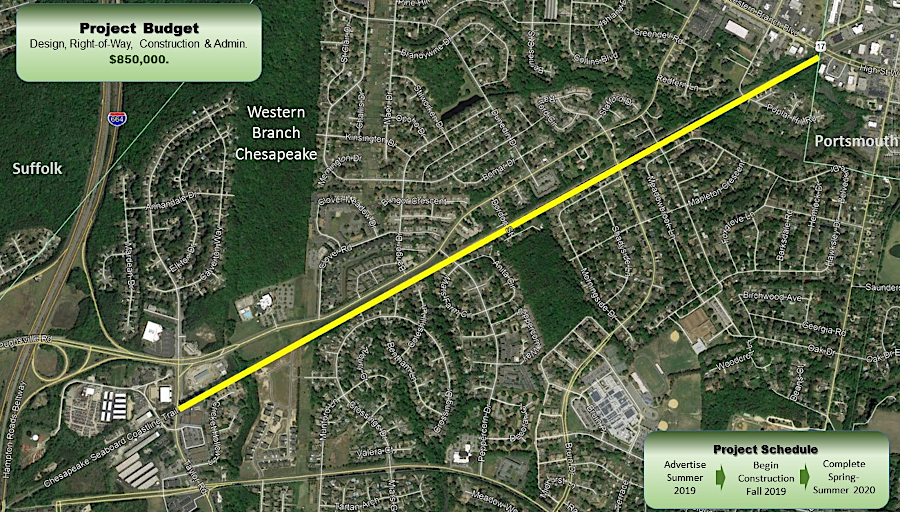
the 3-mile Commonwealth RailwayTrail was planned as part of the 41-mile South Hampton Roads Trail
Source: City of Chesapeake, Citizen Information Meeting, Western Branch Rails-to-Trails Multi-Use Path
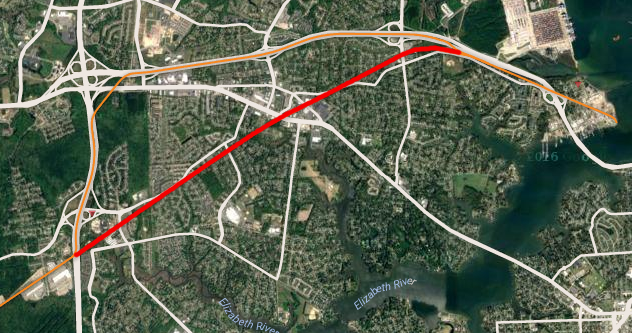
the Commonwealth Railway was realigned as part of the Heartland Corridor project, eliminating road crossings by moving it from the original route (red line) to the medians of the Western Freeway (VA Route 164) and Interstate 664
Source: Genesee & Wyoming Inc., Commonwealth Railway (CWRY)
The Virginia taxpayer funded the $60 million relocation of the railroad. Eliminating the 14 at-grade street crossings benefitted primarily the general public rather than the Commonwealth Railway.
The private railroad did not need to move its line to highway medians for its own purposes, though the relocation did provide brand-new track and railbed infrastructure for operating double-stack container trains and for easier maintenance in the future. The Commonwealth Railway invested $14 million in upgrading its other stretches of track and building the new marshalling yard to assemble long trains.5
The state also funded a portion of the cost for the Commonwealth Railway to purchase about 12 miles of Norfolk Southern track connecting to the Virginia International Gateway (VIG) terminal. Enhancing competition between CSX and Norfolk Southern was expected to increase the number of containers transported through the port and spur local jobs. Ensuring containers could be interchanged equally with two Class I railroads was in the public interest, so the state sought to have the "neutral" Commonwealth Railway rather than Norfolk Southern become the rail provider.
The same theory applied to the Norfolk & Portsmouth Belt Line Railroad, which enabled both Class I railroads to transport containers to the Norfolk International Terminal (NIT) on the eastern side of the Elizabeth River. However, Norfolk Southern ended up owning a majority of that line. CSX used 100 trucks daily rather than the Norfolk & Portsmouth Belt Line Railroad and filed lawsuits, objecting to what it called unfair pricing for access to the Norfolk International Terminal.
If the Craney Island Marine Terminal (CIMT) is constructed, plans include building a 2.75-mile rail extension of the Commonwealth Railway within the Craney Island Road & Rail Connector corridor. The Port of Virginia anticipated that 50% of containers from that proposed terminal would be carried inland by train when the first component opens in 2040, in comparison to 34% in 2016 from the existing terminals.6

railroads in southern Hampton Roads
Source: Virginia Department of Rail and Public Transportation, Virginia Rail Map
Today containers unloaded from ships at Virginia International Gateway (VIG) are moved by trucks or by the Commonwealth Railway. The railroad assembles trains at the terminal and pulls them to the Suffolk Marshalling Yard, where Norfolk Southern or CSX locomotives replace Commonwealth Railway locomotives and transport the trains to the separate tracks of those railroads.

the "neutral" Commonwealth Railway (CWRY) transports containers from Virginia International Gateway (VIG) to both Norfolk Southern and CSX
Source: Virginia Office of Intermodal Planning and Investment, Master Rail Plan for the Port of Virginia (Figure 2)
If business at the terminal expands substantially or if Craney Island Marine Terminal (CIMT) is constructed, the single-line track between the Virginia International Gateway (VIG) and the Suffolk Marshalling Yard will have to be double-tracked. In addition, increased use of the rail network could require separating car and rail traffic at the current CSX and Norfolk Southern at-grade railroad crossings in Suffolk.
The Norfolk Southern retains a competitive edge at the Norfolk International Terminal (NIT) and CSX has a competitive edge at the Portsmouth Marine Terminal (PMT), due to the location of the tracks of those two railroads. The "neutral" access provided by the Commonwealth Railway was intended to create a more balanced business environment at the Virginia International Gateway (VIG) terminal:7

the Commonwealth Railway was moved to the center of the Western Freeway and I-664, eliminating a dozen road crossings
Source: The Heartland Corridor

the Commonwealth Railway is now located in the median of I-664 where it crosses the boundary between the cities of Suffolk and Chesapeake
Source: ESRI, ArcGIS Online

the 41-mile South Hampton Roads Trail (blue line) extends from the Atlantic Ocean to Suffolk, and includes the abandoned portion of the Commonwealth Railway
Source: Hampton Roads Geospatial Exchange Online (HRGEO), South Hampton Roads Trail

the Commonwealth Railway (CWRY) and the Chesapeake & Albemarle Railroad (CA) are both owned by Genesee & Wyoming Inc.
Source: Genesee & Wyoming Inc., Commonwealth Railway (CWRY)

the Commonwealth Railway interchanges with the CSX east of Suffolk
Source: ESRI, ArcGIS Online